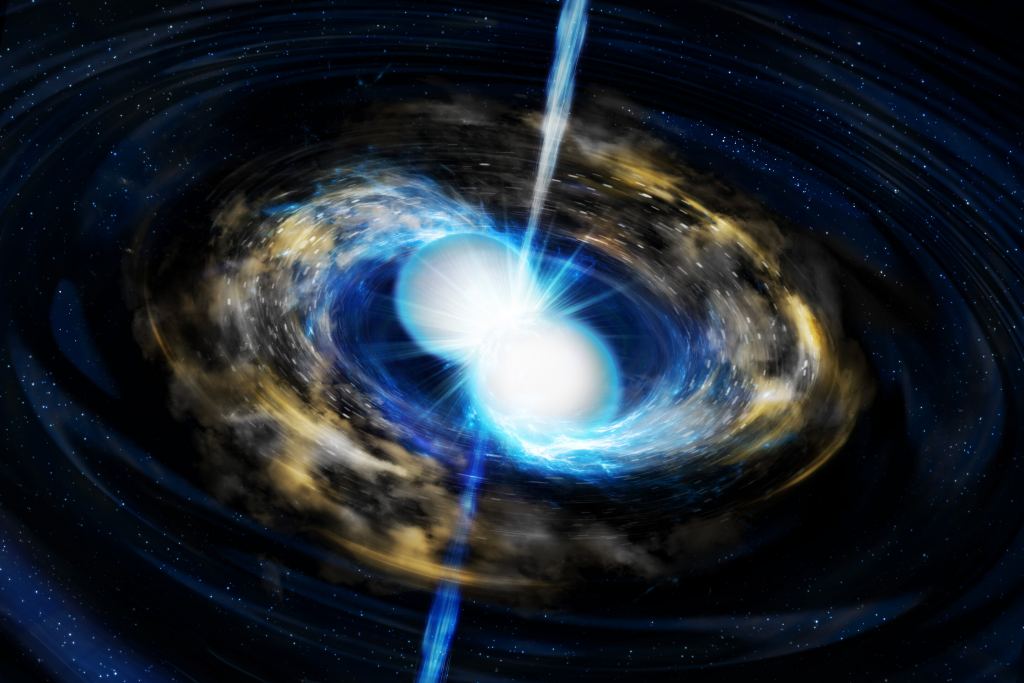When stars reach the end of their life cycle, they shed their outer layers in a supernova. What is left behind is a neutron star, a stellar remnant that is incredibly dense despite being relatively small and cold. When this happens in binary systems, the resulting neutron stars will eventually spiral inward and collide. When they finally merge, the process triggers the release of gravitational waves and can lead to the formation of a black hole. But what happens as the neutron stars begin merging, right down to the quantum level, is something scientists are eager to learn more about.
When the stars begin to merge, very high temperatures are generated, creating "hot neutrinos" that remain out of equilibrium with the cold cores of the merging stars. Ordinarily, these tiny, massless particles only interact with normal matter via weak nuclear forces and possibly gravity. However, according to new simulations led by Penn State University (PSU) physicists, these neutrinos can weakly interact with normal matter during this time. These findings could lead to new insights into these powerful events.
Pedro Luis Espino, a postdoctoral researcher at Penn State and the University of California, Berkeley, led the research. He was joined by fellow astrophysicists from PSU, the Theoretical Physics Institute at the Friedrich Schiller University Jena, the University of Trent, and the Trento Institute for Fundamental Physics and Applications (INFN-TIFPA). A paper describing their simulations, " Neutrino Trapping and Out-of-Equilibrium Effects in Binary Neutron-Star Merger Remnants," recently appeared in the journal *Physical Reviews Letters*.
Originally predicted by Einstein's Theory of General Relativity, gravitational waves (GW) are essentially ripples in spacetime caused by the collapse of stars or the merger of compact objects (such as neutron stars and black holes). Neutron stars are so named because their incredible density fuses protons and electrons together, creating stellar remnants composed almost entirely of neutrons. For years, astronomers have studied GW events to learn more about binary companions and what happens at the moment they merge. Said Pedro Luis Espino, a postdoctoral researcher at Penn State and the University of California, Berkeley, explained in a Penn State press release:
“For the first time in 2017, we observed here on Earth signals of various kinds, including gravitational waves, from a binary neutron star merger. This led to a huge surge of interest in binary neutron star astrophysics. There is no way to reproduce these events in a lab to study them experimentally, so the best window we have into understanding what happens during a binary neutron star merger is through simulations based on math that arises from Einstein’s theory of general relativity.”
While neutron stars are effectively cold, they can become extremely hot during a merger, especially at the interface (the point where the two stars are making contact). In this region, temperatures can reach the trillions of degrees Kelvin, but the stars' density prevents photons from escaping to dissipate the heat. According to David Radice, an assistant professor of astronomy and astrophysics at the Eberly College of Science at Penn State and one of the team leaders, this heat may be dissipated by neutrinos, which are created during the collision as neutrons are smashed to form protons, electrons, and neutrinos.
"The period where the merging stars are out of equilibrium is only 2 to 3 milliseconds, but like temperature, time is relative here, the orbital period of the two stars before the merge can be as little as one millisecond," he said. "This brief out-of-equilibrium phase is when the most interesting physics occurs, once the system returns to equilibrium, the physics is better understood."
To investigate this, the research team created supercomputer simulations that modeled the merger and associated physics of binary neutron stars. Their simulations showed that even neutrinos can be trapped by the heat and density of the merger, that the hot neutrinos are out of equilibrium with the still cool cores, and can interact with the matter of the stars. Moreover, their simulations indicate that the physical conditions present during a merger can affect the resulting GW signals. Said Espino:
“How the neutrinos interact with the matter of the stars and eventually are emitted can impact the oscillations of the merged remnants of the two stars, which in turn can impact what the electromagnetic and gravitation wave signals of the merger look like when they reach us here on Earth. Next-generation gravitation-wave detectors could be designed to look for these kinds of signal differences. In this way, these simulations play a crucial role allowing us to get insight into these extreme events while informing future experiments and observations in a kind of feedback loop.”
This is certainly good news for gravitational wave astronomy and for scientists hoping to use GW events to probe the interiors of neutron stars. Knowing what conditions are present during mergers based on the type of GW signals produced could also provide new insight into supernovae, Gamma-ray Bursts, Fast Radio Bursts, and the nature of Dark Matter.
Further Reading: PSU, *Physical Review Letters*
 Universe Today
Universe Today

